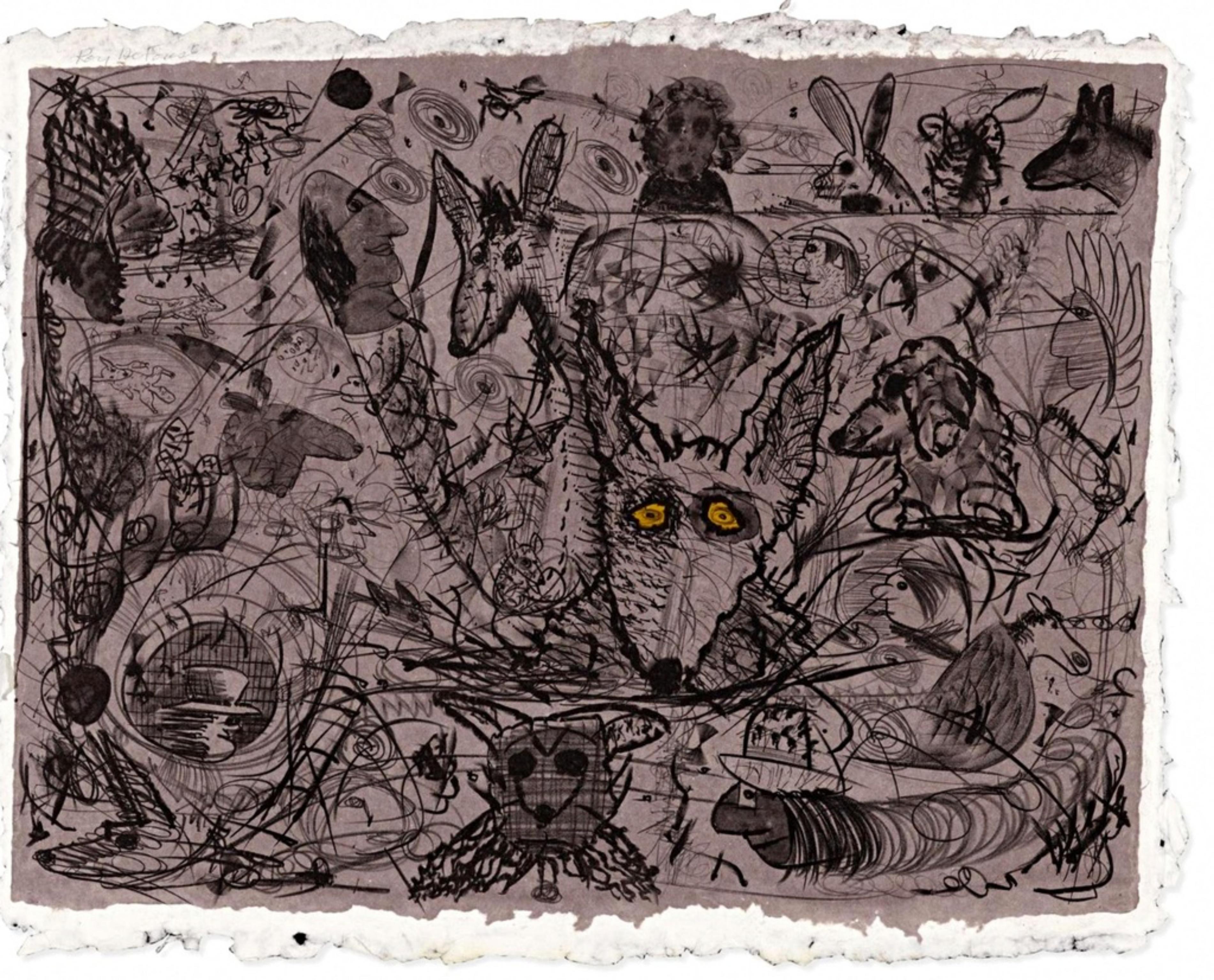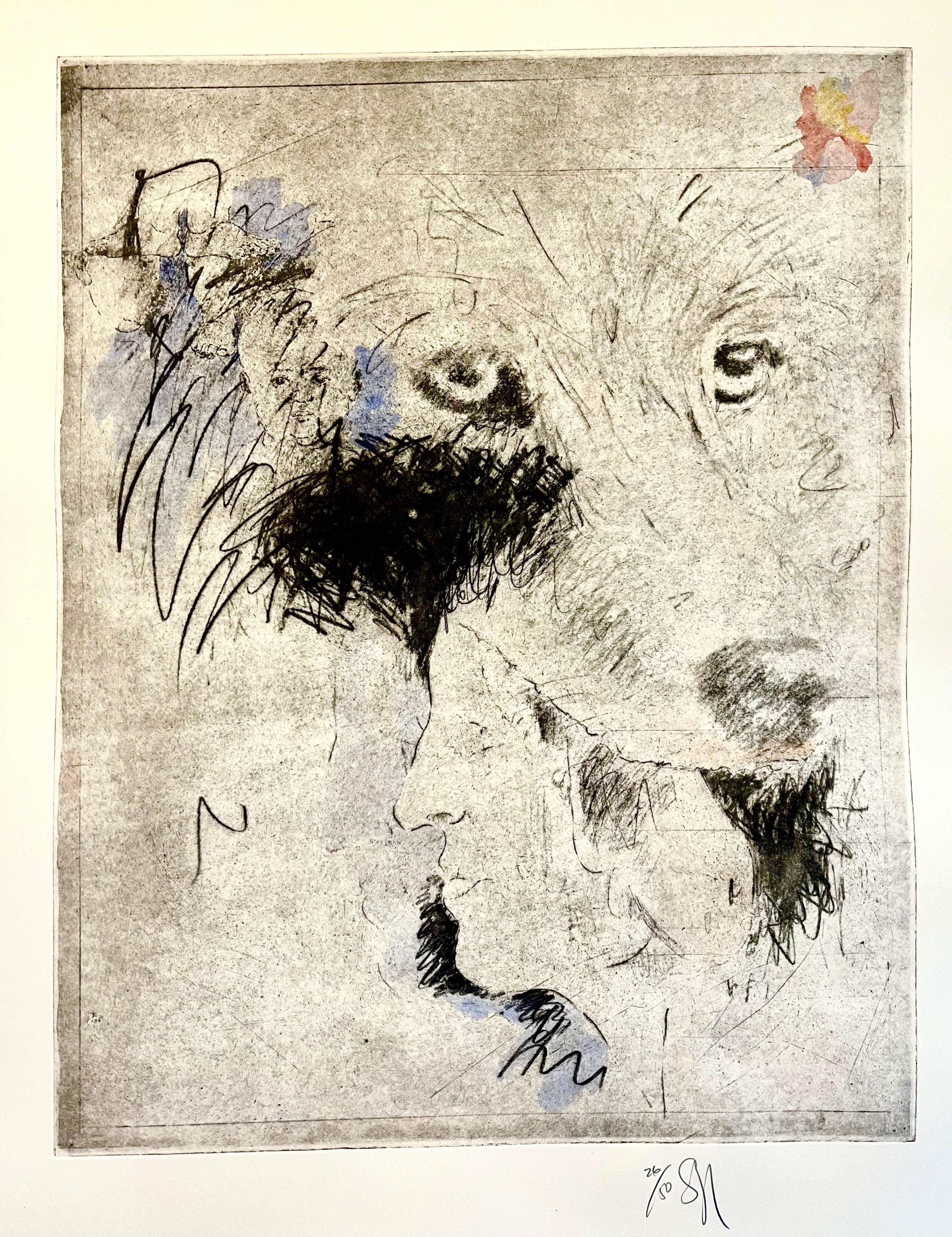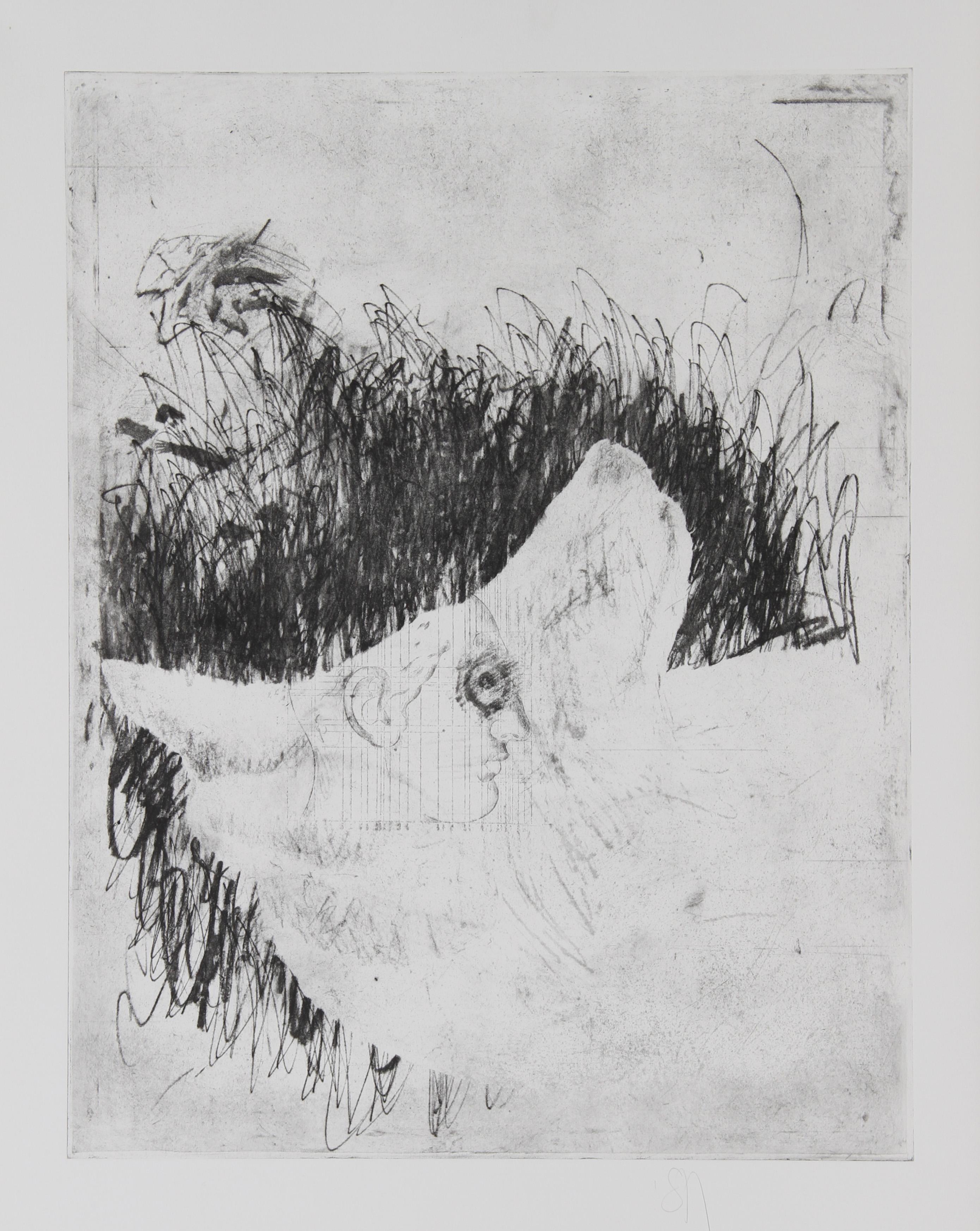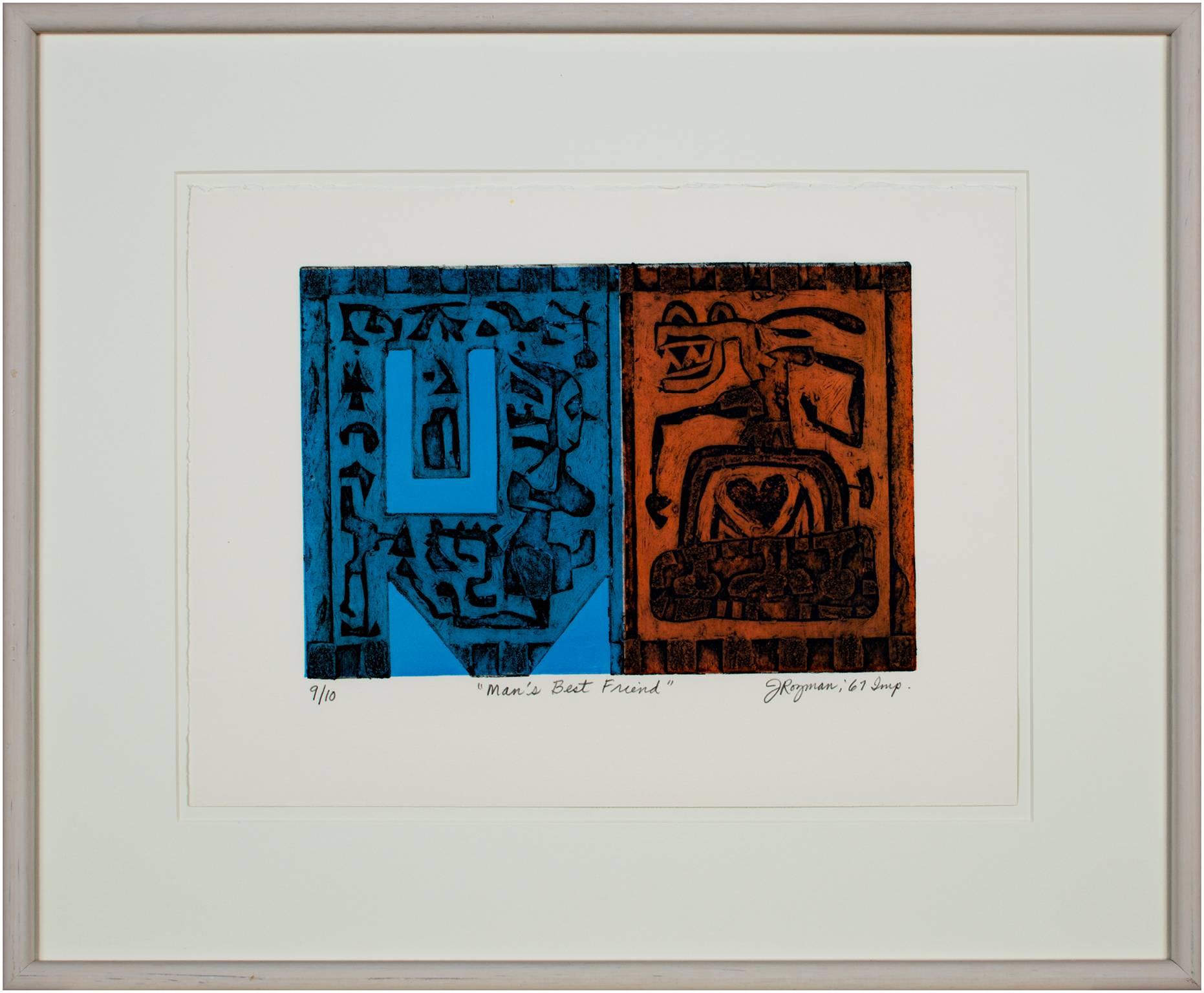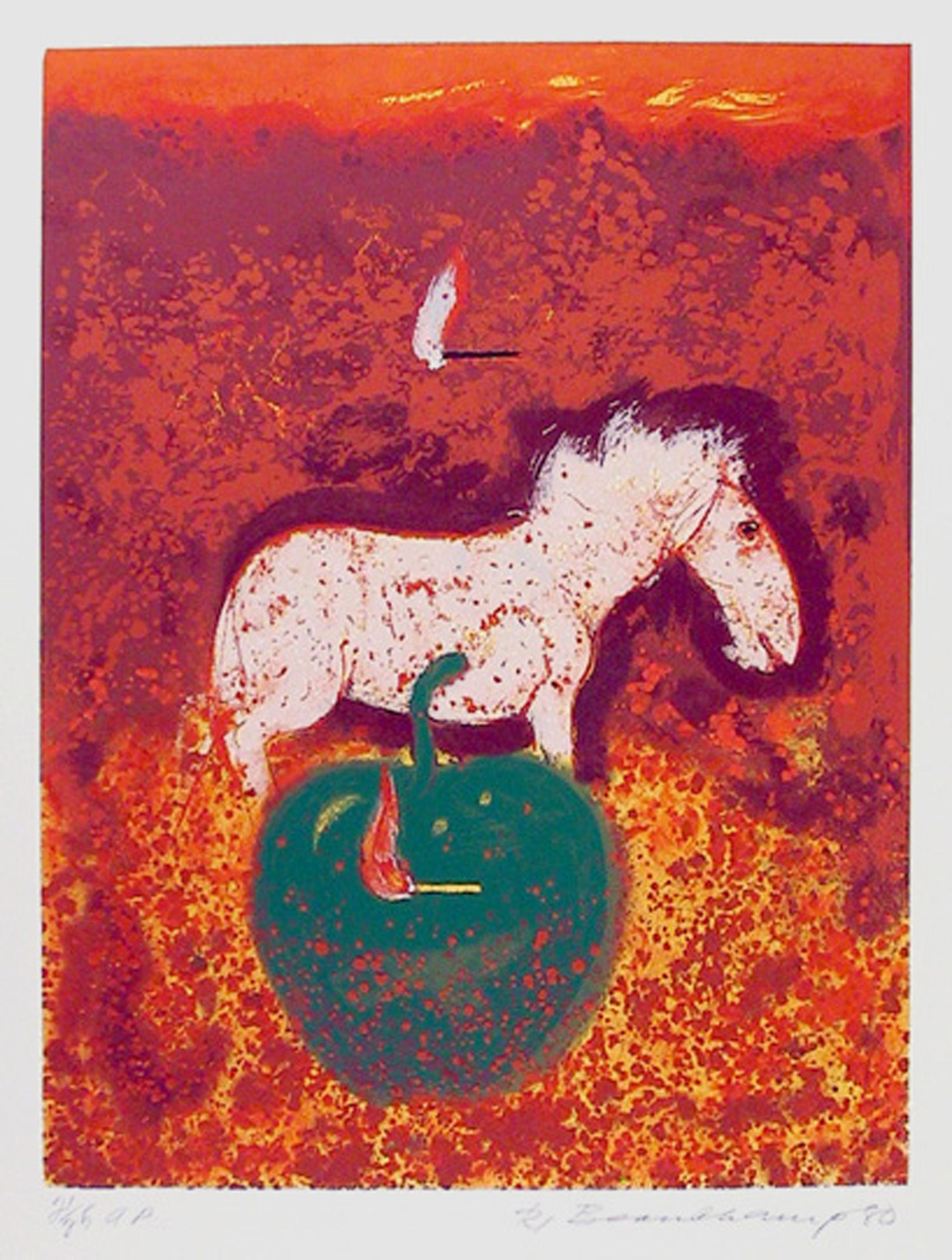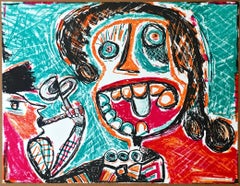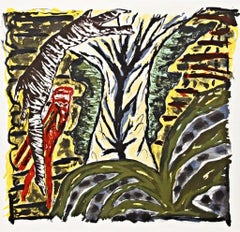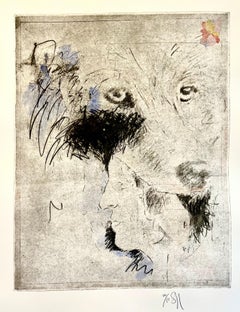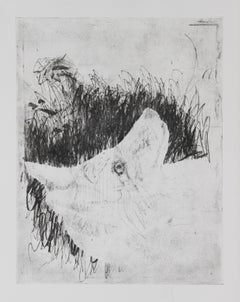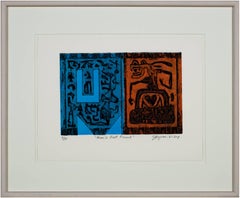Items Similar to Roy De Forest, Dog lithograph, signed/n by world renowned California pet painter
Want more images or videos?
Request additional images or videos from the seller
1 of 13
Roy De ForestRoy De Forest, Dog lithograph, signed/n by world renowned California pet painter1981
1981
$1,700
£1,282.94
€1,468.78
CA$2,397.56
A$2,632.23
CHF 1,373.24
MX$31,853.60
NOK 17,211.40
SEK 16,217.67
DKK 10,964.02
About the Item
Roy De Forest
Untitled (Dog), 1981
Color lithograph with deckled edges. Floated and framed.
Pencil signed and numbered from the edition of 125
Frame Included: held in original vintage white frame
Wonderful whimsical rare 1981 lithograph by the incredibly popular and beloved Roy de Forest, famous for his paintings and prints of dogs, and one of the leaders of the California funk art movement, who developed a cult following of incredibly loyal fans, followers and collectors. Makes a memorable fine art gift for any dog lover.
Measurements:
Sheet: 30" x 22"
Framed: 35 1/4" x 26 3/4"
It's in the original vintage 1981 frame.
About Roy De Forest:
Roy De Forest was born in North Platte, Nebraska in 1930 and raised in Yakima Valley Washington. He moved to San Francisco in 1950 to attend the California School of Fine Art, where he studied with painters such as Elmer Bischoff, Edward Corbett, David Park and Hassel Smith, whose evening seminars were particularly influential to De Forest and his peers. This second generation of abstract expressionist painters included Robert Morris, Sonia Gechtoff, Seymour Locks and Deborah Remington, and formed the core of the artist-run, alternative spaces such as the Ubu Gallery and later the Six, Spasta and Batman Galleries which opened in San Francisco during the 1950s. While De Forest received his BA in 1953, he was soon drafted to serve in the Korean War, stationed in Washington as a sign painter for two years. Returning to San Francisco in 1955, he continued to work abstractly while exhibiting within the milieu of his former classmates. He received his MFA from San Francisco State University in 1956, but a work-place accident in 1958 precipitated his acceptance of a teaching position back at Yakima Junior College, his alma mater.
Returning to Washington, De Forest soon began experimenting with sculpture, painted constructions he referred to as “Boardisms.” However his adoption of mixed media and acrylics in his paintings, namely his signature raised paint dots, and more formally complex compositions indicated the direction his art would take. A love of pulp fiction and poetry alike inspired fanciful, evocative titles for his paintings and sculptures, which by 1960 were beginning to include narrative and figurative elements. It was that same year De Forest returned to the Bay Area and had his first of many exhibitions at Dilexi Gallery, the influential San Francisco venue which was instrumental in promoting the careers of many Northern California artists in the 1960s and 1970s. Over the next few years De Forest established his vibrant, collaged style and a pantheon of characters which would continue to populate his work such as brick men, devils, ships, hermits, horses, blond women and above all, dogs.
In 1965 he was hired to teach at the University of California, Davis, where close friends Robert Arneson and William T Wiley were already on the faculty. The unstructured environment and camaraderie between students and professors alike, proved inspirational for many of the artists there at the time, De Forest included. While he was included in the Funk show at the Berkeley Art Museum in 1967, it was the loose collection of artists - many affiliated with UC Davis - who coined the term “Nut Art” that was more critical to De Forest’s own identity as an artist. Envisioned as a contrarian non-style, at odds with the perceived elitism of contemporary art movements, “Nut Art” had no particular defining aesthetic beyond the individualism of the artist. Its members, who included Arneson, Clayton Bailey, Richard Shaw, David Gilhooly, David Zack and Maja Peeples-Bright, variously described their invention as “the mad genius in all of us” where “the work of a peculiar and eccentric nut can truly be called ‘nut art’.” De Forest’s own mad genius combined the grand mythology of the American West with an erudite introspection. In much of his work the narrative is that of a journey, generally over water or mountains, by boat, plane or foot. However the journey also can be a metaphorical one, of self-discovery or enlightenment; windows are a common motif, as a mediating device or a physical portal between pictorial spaces. Despite the apparently whimsical nature of his work, De Forest pulled from a wide range of sources and was well versed in art history - a long standing game with his colleague Wayne Thiebaud involved them trying to stump each other with the names of obscure artists.
De Forest called art “one of the last strongholds of magic” and described his richly colored and textured fantasy worlds as “unknowable [though] hauntingly familiar.” Despite his eccentric nature, by the early 1970s he was gaining national attention, with gallery representation in both San Francisco and New York. His first major museum show was a mid-career retrospective in 1974 at the San Francisco Museum of Art, which traveled to the Fort Worth Art Center, TX; Utah Museum of Fine Arts, Salt Lake City; and the Whitney Museum of American Art, New York. While De Forest had generally abandoned sculpture in favor of painting by this point, he did continue to fabricate increasingly elaborate frames for both his paintings and his drawings. The drawings in particular were often given highly decorative, modeled and painted frames, which grew in complexity in later years. By the early 1980s however, he once again began to experiment with sculpture, though these later pieces have more in common with his paintings than the abstract constructions of the late 1950s and early 1960s. Much of his work from the early 1990s onward is more construction than painting alone; beyond the frames themselves, there are dimensional figurative elements and his canvases tend to unorthodox shapes. His late sculpture culminated in a series of Dog Benches: cast, polychrome functional sculptures featuring, predictably, dogs. De Forest retired from Davis and teaching in 1992, though he continued to work and exhibit up until his death in 2007.
De Forest exhibited widely during his lifetime, enjoying success on both the east and west coasts. He was the subject of two major retrospectives, the first in 1974 which traveled nationally and another, posthumously in 2017, organized by the Oakland Museum of California. He was the recipient of several major grants and awards, including a National Endowment for the Arts Fellowship in 1972 and an honorary doctorate from the San Francisco Art Institute in 1983. His work can be found in major public collections internationally, including the San Francisco Museum of Modern Art; the Whitney Museum of American Art, New York; the Art Institute of Chicago; the Honolulu Museum of Art; the Philadelphia Art Museum; the Smithsonian American Art Museum, Washington, DC; Virginia Museum of Fine Arts, Richmond; and the Centre Georges Pompidou, Paris, France.
-Courtesy of George Adams Gallery
- Creator:Roy De Forest (1930 - 2007, American)
- Creation Year:1981
- Dimensions:Height: 35.25 in (89.54 cm)Width: 26.75 in (67.95 cm)Depth: 1 in (2.54 cm)
- Medium:
- Movement & Style:
- Period:
- Condition:not examined outside of vintage frame but appears to be in fine condition.
- Gallery Location:New York, NY
- Reference Number:1stDibs: LU1745216146242
About the Seller
5.0
Platinum Seller
Premium sellers with a 4.7+ rating and 24-hour response times
Established in 2007
1stDibs seller since 2022
451 sales on 1stDibs
Typical response time: 2 hours
- ShippingRetrieving quote...Shipping from: New York, NY
- Return Policy
Authenticity Guarantee
In the unlikely event there’s an issue with an item’s authenticity, contact us within 1 year for a full refund. DetailsMoney-Back Guarantee
If your item is not as described, is damaged in transit, or does not arrive, contact us within 7 days for a full refund. Details24-Hour Cancellation
You have a 24-hour grace period in which to reconsider your purchase, with no questions asked.Vetted Professional Sellers
Our world-class sellers must adhere to strict standards for service and quality, maintaining the integrity of our listings.Price-Match Guarantee
If you find that a seller listed the same item for a lower price elsewhere, we’ll match it.Trusted Global Delivery
Our best-in-class carrier network provides specialized shipping options worldwide, including custom delivery.More From This Seller
View AllUntitled Signed lithograph on Arches paper by world famous dog artist, unique TP
By Roy De Forest
Located in New York, NY
ROY DE FOREST
Untitled, 1981
Lithograph on Arches paper with four deckled edges.
22 1/2 × 30 inches
Hand signed and annotated Trial Proof, aside from the regular edition of 60
Unfra...
Category
1980s Contemporary Animal Prints
Materials
Archival Paper, Pencil, Graphite, Lithograph
Untitled, expressionistic woodcut print, from the Art Against AIDS Portfolio
By James Bettison
Located in New York, NY
James Bettison
Untitled, from the Art Against AIDS Portfolio, 1988
Woodcut on paper with deckled edges. Hand signed. Numbered 38/50. Dated. Printer's and Publisher's Blind Stamp.
20...
Category
1980s Contemporary Abstract Prints
Materials
Woodcut, Pencil
Untitled Figure signed numbered mixed media print from scarce European portfolio
By George McNeil
Located in New York, NY
George McNeil
Untitled Figure, 1986
Lithograph on paper. Publisher's and Printer's Blind
Stamps
Hand-signed, numbered 78/84 and dated by the artist on the front with publisher's and...
Category
1980s Abstract Expressionist Figurative Prints
Materials
Lithograph, Screen, Pencil
El Santuario de Chimayó, large lithograph, signed, numbered 1/40 renowned artist
By Gregory Amenoff
Located in New York, NY
GREGORY AMENOFF
El Santuario de Chimayó, 1986
Lithograph in Colors on wove paper
37 × 38 inches
Edition 1/40
Hand Signed, titled, dated, and numbered in pencil 1 from the edition of ...
Category
1880s Abstract Expressionist Abstract Prints
Materials
Lithograph
Rare offset lithograph poster (signed and inscribed to founder, Tallix Foundry)
By Nancy Graves
Located in New York, NY
Nancy Graves
Nancy Graves: A Survey 1969/1980 (Hand signed and inscribed to Dick Polich of Tallix), 1980
Offset lithograph poster (hand signed, dated and inscribed)
signed, dated and...
Category
1980s Abstract Expressionist Abstract Prints
Materials
Offset
Thou Shalt Have No Other Gods Before Me, The 1st Commandment Lithograph Signed/N
By Kenny Scharf
Located in New York, NY
Kenny Scharf
Thou Shalt Have No Other Gods Before Me (The First Commandment), 1987
5-Color lithograph on Dieu Donne handmade paper with deckled edges
24 × 18 inches
Hand signed, date...
Category
1980s Pop Art Abstract Prints
Materials
Lithograph
You May Also Like
Large Donald Saff Surrealist Pop Art Aquatint Etching Wolf, Man
By Donald Saff
Located in Surfside, FL
Artist: Donald Saff
Title: Wolf and Man
Year: 1980
Medium: Etching with Aquatint, Hand signed and numbered in pencil
Edition: 50
39 in. x 27.5 in.
Donald Jay Saff (born 12 Decemb...
Category
1980s Pop Art Figurative Prints
Materials
Etching, Aquatint
Wild Wolves - Original Lithograph, Stamp Signature
By Pierre Ambrogiani
Located in Paris, IDF
Pierre AMBROGIANI (1907-1985)
Wolves, 1974
Original Lithograph (Gourdon Workshop)
Signed with the artist's stamp
On vellum 38 x 28 cm (c. 14.9 x 11 in)
Excellent condition
Category
Mid-20th Century Expressionist Animal Prints
Materials
Lithograph
Coyote, Etching by Donald Saff
By Donald Saff
Located in Long Island City, NY
Coyote
Donald Saff, American (1937)
Date: 1980
Etching, signed and numbered in pencil
Edition of AP
Image Size: 24 X 18.5 inches
Size: 30 in. x 22 in. (76.2 cm x 55.88 cm)
Category
1980s Conceptual Prints and Multiples
Materials
Etching
"Man's Best Friend" Original Color Collagraph signed by Joseph Rozman
By Joseph Rozman
Located in Milwaukee, WI
"Man's Best Friend" is an original color collograph in blue and red by Joseph Rozman. It depicts an animal in red on the right and a figure among abstract shapes in blue on the left....
Category
1960s Surrealist Animal Prints
Materials
Color
Blaze, Surrealist Lithograph by Robert Beauchamp
By Robert Beauchamp
Located in Long Island City, NY
Robert Beauchamp, American (1923 - 1995) - Blaze, Year: 1980, Medium: Lithograph, signed and numbered in pencil, Edition: 200, Size: 32 in. x 25 in. (81.28 cm x 63.5 cm)
Category
1980s Surrealist Animal Prints
Materials
Lithograph
"Hunting, " Original Etching and Aquatint signed by Molly McKee
By Molly McKee
Located in Milwaukee, WI
"Hunting" is an original etching and aquatint by Molly McKee. The artist signed the piece in the lower right, titled it lower center, and wrote the edition number (2/10) in the lower left. It depicts a few abstracted human figures in McKee's surreal and horror-inspired style.
11 3/4" x 9" art
24 7/8" x 17 1/2" frame
This surreal etching...
Category
1990s Surrealist Figurative Prints
Materials
Etching, Aquatint
More Ways To Browse
Cult Of Vintage
Prints Of Dogs
Deborah Remington
Bighorn Ram
Cat In The Hat
Charles White Lithograph
Combat Pour La Paix
Copper Etching Original
Dr Seuss Art
Ken Price Cup
Long Billed Curlew
Mark Sabin
Pablo Picasso Dove
Picasso Lithograph Peace
Picasso Pigeons Lithograph
Robert Greenhalf
The Owl Lithograph
Vintage Basset Hound Art
